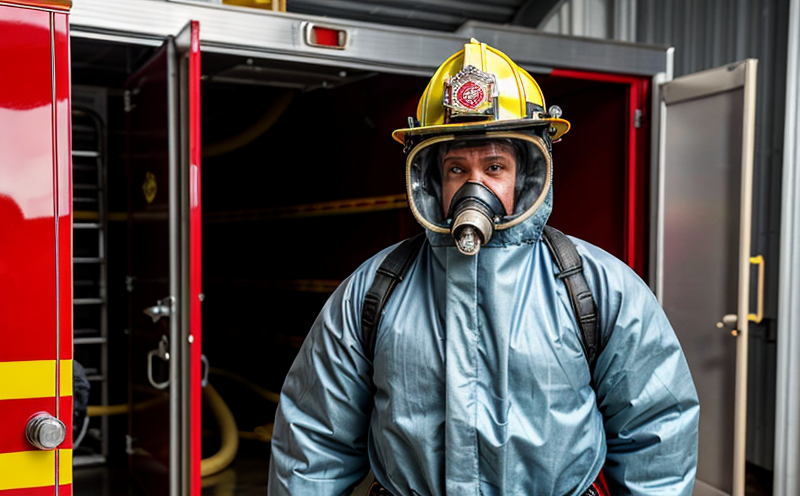Firefighter Hood Flame Resistance Testing
The importance of flame resistance in firefighter protective clothing and equipment cannot be overstated. Firefighters are constantly exposed to hazardous environments where fire, heat, and smoke pose significant risks. Ensuring that their protective gear is up to the mark is a key responsibility for quality managers, compliance officers, R&D engineers, and procurement personnel. One critical aspect of this protection involves testing the flame resistance of firefighter hoods.
The primary purpose of flame resistance testing in firefighter hood materials is to assess how well these textiles can withstand exposure to fire without igniting or burning. This testing helps ensure that the fabric used in firefighter hoods meets strict standards, thereby safeguarding the lives and health of firefighters during emergencies. The testing process typically involves exposing a sample of the material to specific conditions designed to mimic real-world fire scenarios.
The test outcomes are crucial for compliance officers responsible for ensuring adherence to international standards like ISO 11697-1, which specifies requirements and test methods for flame resistance of textile materials intended for use in protective clothing. For R&D engineers, this testing provides invaluable data for product development and improvement. Procurement personnel can rely on these results to select suppliers who meet the necessary quality benchmarks.
The testing process is rigorous and involves controlled conditions that simulate actual fire situations. The sample material is subjected to a specified heat source for a defined period, after which it undergoes detailed examination to assess its resistance to ignition, flaming behavior, and recovery properties. This information ensures that firefighters can rely on their protective gear in critical moments.
The results of this testing are essential not only for ensuring the safety of firefighters but also for maintaining compliance with regulatory requirements. By adhering to these standards, manufacturers can demonstrate a commitment to producing high-quality protective equipment that meets or exceeds international expectations. This is particularly important given the unpredictable nature of firefighting operations and the potential hazards they pose.
In summary, flame resistance testing for firefighter hoods plays a pivotal role in enhancing fire safety by ensuring that firefighters are equipped with materials capable of withstanding extreme heat and flames without igniting or sustaining significant damage. The process involves controlled experimentation under standardized conditions to provide reliable data on material performance. This information is crucial for maintaining compliance with relevant standards, supporting product development, and informing procurement decisions.
Scope and Methodology
| Test Parameter | Description | Standard Reference |
|---|---|---|
| Sample Preparation | Materials are cut into standard-sized specimens with a specified thickness. | ISO 11697-1 |
| Heat Source | A propane flame is used to expose the sample for a set duration. | ASTM E2034 |
| Flame Exposure Time | The sample is exposed to the flame for 15 seconds. | - |
| Post-Test Evaluation | Specimens are inspected for ignition, flaming behavior, and recovery properties. | - |
| Repeatability | Tests are conducted multiple times to ensure consistency of results. | ISO 11697-1 |
The testing procedure begins with the careful preparation of the sample, ensuring it meets the specified dimensions and thickness. The heat source is then applied for a predetermined duration, simulating real-world fire conditions. After exposure to the flame, the specimen undergoes thorough evaluation for any signs of ignition or continued flaming. Recovery properties are also assessed to determine how quickly the material returns to its original state post-exposure.
The repeatability aspect ensures that results can be consistently reproduced across multiple tests, providing reliable data for quality assessment and compliance verification. By adhering to these rigorous protocols, laboratories can provide accurate and trustworthy test outcomes that contribute significantly to fire safety in the field of firefighting equipment.
Industry Applications
The application of flame resistance testing is widespread within the fire service sector. Quality managers rely on this testing to ensure that all materials used meet strict standards, thereby enhancing product reliability and performance. Compliance officers use these results to verify adherence to regulatory requirements, ensuring that equipment is safe for use by firefighters.
R&D engineers benefit from detailed test data which helps in refining and developing new products with improved flame resistance properties. Procurement teams can leverage the outcomes of this testing when selecting suppliers who meet stringent quality criteria. This approach not only ensures product safety but also supports continuous improvement within the industry.
In addition to its immediate applications, flame resistance testing for firefighter hoods is crucial in maintaining public confidence and trust in firefighting equipment. By adhering to international standards such as ISO 11697-1 and ASTM E2034, manufacturers can demonstrate a commitment to producing reliable and safe products.
This commitment extends beyond mere compliance; it reflects an ongoing dedication to the well-being of firefighters who depend on this gear for their safety. By incorporating rigorous testing into product development processes, manufacturers contribute significantly to enhancing fire safety practices globally.
Use Cases and Application Examples
- Field Testing: In a controlled environment, samples of firefighter hoods are exposed to flames for 15 seconds as per ASTM E2034. This helps in determining the ignition point and flaming duration.
- R&D Applications: Engineers use test results to modify fabric composition and design, improving heat resistance and recovery properties.
- Manufacturing Quality Control: Laboratories conduct tests on incoming materials to ensure they meet specified standards before integration into products.
- Regulatory Compliance: Compliance officers review test data to verify adherence to international standards like ISO 11697-1 and ASTM E2034.
- Purchasing Decisions: Procurement teams use these results when selecting suppliers, ensuring that only high-quality materials are used in the production of firefighter hoods.
The detailed insights provided by flame resistance testing allow for more informed decisions across various stages of product development and quality assurance. This comprehensive approach ensures that firefighters have access to the most reliable and safe protective equipment possible.





